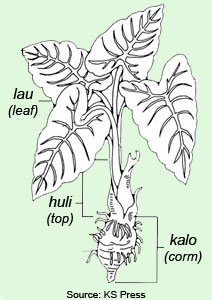
When the kalo plant is harvested, it is usually cut up and separated into three parts:  the lau, the huli, and the kalo. Each component has specific use and no part of the plant is wasted.
the lau, the huli, and the kalo. Each component has specific use and no part of the plant is wasted.
Lau – The lau, also known as the leaf, of the kalo helps to determine the variety of taro in some cases. Some characteristics of the leaf that helps in determining the variety of kalo is its size and color. The leaf is used to make food dishes such as laulau and lū‘au. Wrapping pork or chicken with lau and then steaming it makes laulau. In traditional times before electric ovens, laulau was cooked in an imu (underground oven). To make lū‘au, lau was boiled until it broke apart. The water was then drained and the cooked lau is mixed with he‘e (squid) or moa (chicken) and coconut milk.
Kalo – The kalo is the corm of the plant. This is the part of the plant that is used to make poi, the staple food of the Hawaiian people.
Huli – The huli is the remaining part of the kalo after the lau and the kalo have been cut off. The huli consist of the crown of the kalo, which will bear new roots when planted back in the lo‘i.